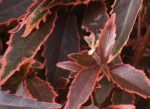
Beefsteak plant is a clump-forming broadleaf evergreen shrub native to Polynesia and is a member of the spurge family, Euphorbaceae, that also includes poinsettia, croton, and caster oil plant. It grows 60-79 ” tall and has densely branched stems carrying ovate leaves with pointed tips and toothed margins. The leaves are up to 6″ long and dark green variegated with pink. Axillary catkins of male and female flowers are produced on different plants in summer. Male catkins are 4.7″ long while female catkins are 3″ long. The inconspicuous flowers are small, petaless, and greenish. The fruits are tiny red capsules. The plant is grown for its striking foliage that can add a tropical look to a garden as a hedge, specimen, or container plant. If grown in a container, the plant will be smaller and can be taken in doors in the fall in hardiness zones colder than 9. The genus name, Acalypha, comes from akalephe, the ancient Greek name for nettle, and refers to the nettle-like appearance of the leaves. The specific epithet, godseffiana, honors Joseph Godseff (ca. 1846 – 1921), a professional English plant collector.
Type: Broadleaf evergreen shrub
Outstanding Feature:Foliage coloration
Form: Rounded
Growth Rate: Rapid
Bloom: Inconspicuous flowers in male and female catkins on different plants, in summer
Size: 60-79″ H x 60-79″ W
Light: Full sun to partial shade but best color and bushiness in full sun
Soil: humusy, fertile, consistently moist, well-drained
Hardiness: Zones 9-11
Care: Pinch to keep plants bushy
Pests and Diseases: None of significance
Propagation: Sit layering cuttings in early spring to summer
Outstanding Selections: ‘Heterophylla’ ( 12″ tall, yellow edged leaves on drooping branches)
A densely branched rounded shrub mostly 1–2 m tall, monoecious, tomentellous to pubescent.Petioles 1–5 cm long.Leaf blades usually up to 15 × 10 cm, sometimes larger, elliptic-ovate to broadly ovate, obtusely acuminate at the apex, crenate-dentate on the margins, cuneate or rounded at the base, 5–7-nerved from the base, membranous, sparingly pubescent along the midrib and main veins on both surfaces at first, later glabrescent, green, copper or bronze and variously variegated with purple, red, pink, cream-coloured or white, or else pink-, cream- or white-margined; lateral nerves in 6–10 pairs.Stipules 7 mm long, narrowly lanceolate, acutely acuminate.Inflorescences axillary, usually solitary, spicate, unisexual, on the same or different shoots.Male spikes up to 12 cm long, densely but interruptedly flowered; bracts minute, many-flowered.Female spikes up to 7 cm long, lax flowered; bracts c. 5 × 4 mm, ± ovate, later accrescent, dentate, with 3–6 teeth on each side, sparingly pubescent to subglabrous, 1-flowered.Male flowers sessile or ± so; buds tetragonal, subglabrous, reddish; anthers yellowish.Female flowers sessile; sepals 3–4, 1 mm long, ovate, subacute; ovary 1.5 mm in diameter, subglobose, tomentose; styles c. 6 mm long, united at the base, deeply laciniate, red.Fruits 1.5–2 × 4 mm, 3-lobed, pubescent.Seeds not set in Africa.
| rowth Form | A fast-growing, clumping, medium-sized to tall shrub that is often grown for its beautiful foliage of juxtaposing dark green leaves with striking pink margins. |
| Foliage | Leaves simple, alternate, dark green, narrowly elliptic, with pink, wavy or toothed margins. |
| Stems | Stems woody, brown; young stems pale green with a tinge of pink, herbaceous |
| Flowers | Inflorescences inconspicuous, pinkish green, in axillary spikes, up to 18 cm long; flowers white, corolla absent; calyx small; sepals inconspicuous; male spikes generally with more flowers; female spikes with less flowers, each of which is borne in a bract. |
| Fruits | Fruits in a form of capsules. |
| Cultivation | It can take full sun or partial shade but requires the former to develop vibrant colours on foliage. Specimens grown under shade will not be as colourful. A fast-growing shrub, it likes well-drained soil with regularly sprinkled with organic matter. Careful and occasional pruning is required to prevent them from becoming leggy. Propagate by cuttings, which can be done with ease. |
| Etymology | The genus epithet ‘Acalypha’ was indirectly named by a Greek physician (ca. 460 – 370 B.C.), who was known as the ‘father of medicine’ and gave the name ‘acalephe’ to a nettle he described. It was then transferred by latter-day botanists to this group of plants in the spurge family, which means ‘a stinging nettle’, in reference to the irritating sap produced by plants of this genus. The species epithet ‘godseffiana’ honours after Joseph Godseff (ca. 1846 – 1921), a plant collector for the English nursery trade. Its cultivar epithet derives from two Greek words ‘heteros’, meaning ‘different’, and ‘phylla’ meaning ‘leaves’, in reference to its greatly erratic formation of irregular, shaggy, wide to narrow leaves displayed on each plant. |